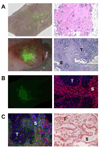Stroma in breast development and disease
- PMID: 19857593
- PMCID: PMC2823823
- DOI: 10.1016/j.semcdb.2009.10.003
Stroma in breast development and disease
Abstract
It is increasingly apparent that normal and malignant breast tissues require complex local and systemic stromal interactions for development and progression. During development, mammary cell fate specification and differentiation require highly regulated contextual signals derived from the stroma. Likewise, during breast carcinoma development, the tissue stroma can provide tumor suppressing and tumor-promoting environments that serve to regulate neoplastic growth of the epithelium. This review focuses on the role of the stroma as a mediator of normal mammary development, as well as a critical regulator of malignant conversion and progression in breast cancer. Recognition of the important role of the stroma during the progression of breast cancers leads to the possibility of new targets for treatment of the initial breast cancer lesion as well as prevention of recurrence.
Copyright 2009 Elsevier Ltd. All rights reserved.
Figures

References
-
- DeOme KB, Faulkin LJ, Jr, Bern HA, Blair PB. Development of mammary tumors from hyperplastic alveolar nodules transplanted into gland-free mammary fat pads of female C3H mice. Cancer Res. 1959;19:515–520. - PubMed
-
- Daniel CW, DeOme KB. Growth of mouse mammary glands in vivo after monolayer culture. Science. 1965;149:634–636. - PubMed
-
- Barcellos-Hoff MH, Ravani SA. Irradiated mammary gland stroma promotes the expression of tumorigenic potential by unirradiated epithelial cells. Cancer Res. 2000;60:1254–1260. - PubMed
Publication types
MeSH terms
Grants and funding
LinkOut - more resources
Full Text Sources
Other Literature Sources
Medical

